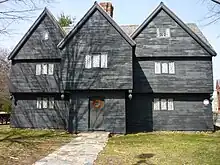The Witch House
The Jonathan Corwin House, known locally as The Witch House, is a historic house museum at 310 Essex Street in Salem, Massachusetts. It was the home of Judge Jonathan Corwin (1640–1718), and is the only structure still standing in Salem with direct ties to the Salem witch trials of 1692. Corwin bought the house in 1675 when he was 35, and lived there for more than 40 years; the house remained in the Corwin family until the mid-19th century.[2][3]
Jonathan Corwin House | |
 | |
| Location | Salem, Massachusetts |
|---|---|
| Coordinates | 42.5215°N 70.8989°W |
| Built | 1642 (Traditional) c. 1675 (MACRIS)[1] |
| Restored | 1945 |
| Part of | Chestnut Street District (ID73000312) |
History
Corwin was called upon to investigate the claims of diabolical activity when a surge of witchcraft accusations arose in Salem Village (now Danvers) and neighboring communities. He took the place of Judge Nathaniel Saltonstall, who resigned after the execution of Bridget Bishop. Corwin served on the Court of Oyer and Terminer, which ultimately sent 19 people to the gallows.
The house is an excellent example of 17th-century New England architecture, although historians are unsure of the date when it was built. Corwin family lore maintains that it was built in 1642, but some scholars claim that it was built in the 1620s or 1630s and that Roger Williams lived in it in the before he founded Providence Plantations.[4]
The house was moved about 35 feet (11 m) to its current location in the 1940s when the adjacent street was widened. It was restored to look as it would have in the 17th century and the gambrel roof was altered. It is now a museum operated by the City of Salem and is open seasonally.[5] In 2011, the Ghost Adventures crew featured it during season 4.[6]
Gallery
 Sketch of the "Witch House" c.1819
Sketch of the "Witch House" c.1819 "Witch House" taken in 1865 from Essex/North Street.
"Witch House" taken in 1865 from Essex/North Street. Sketch of the "Witch House" from 1896.
Sketch of the "Witch House" from 1896. "Witch House" taken in 1901 from Essex Street.
"Witch House" taken in 1901 from Essex Street. "Witch House" (center) taken in 1906 from North Street.
"Witch House" (center) taken in 1906 from North Street. Front of the "Witch House" taken in 2010 from Essex Street.
Front of the "Witch House" taken in 2010 from Essex Street.
See also
References
- "Corwin, Judge Jonathan House". Massachusetts Cultural Resource Information System (downloadable PDF). Retrieved June 13, 2022.
- Schiff, Stacy (October 24, 2015). "Opinion | First, Kill the Witches. Then, Celebrate Them". The New York Times. Retrieved July 28, 2022 – via NYTimes.com.
- Tabor, Mary B. W. (September 9, 1991). "Salem Journal; 'The Witch City' Dusts Off Its Past". The New York Times. Retrieved July 28, 2022 – via NYTimes.com.
- "Press Release "The Witch House Begins Architectural History Study" 1/23/2008 (accessed July 14, 2008)". Archived from the original on June 8, 2008. Retrieved July 28, 2022.
- "Five places to explore Salem's witchy past -- and the memorials to its victims". Los Angeles Times. October 30, 2015. Retrieved July 28, 2022.
- "S4-18 Salem Witch House". www.ghostadventurescrew.com. Archived from the original on June 5, 2017.
External links
 Media related to The Witch House at Wikimedia Commons
Media related to The Witch House at Wikimedia Commons- Official website
- Salem Web – information on the Witch House
